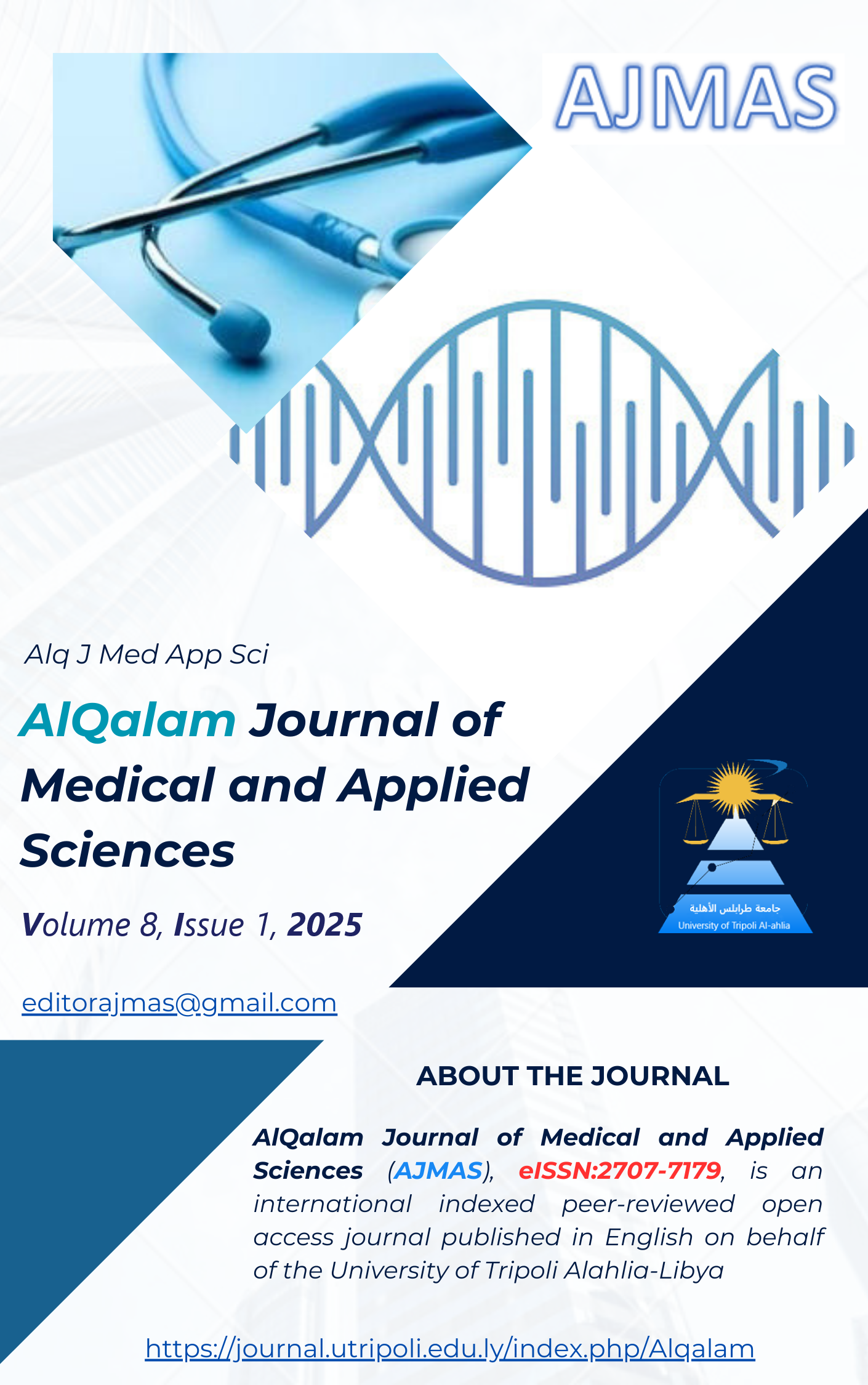Epidemiological Features and Risk Factors of Herpes Zoster in Western Libya: A Retrospective Study
DOI:
https://doi.org/10.54361/ajmas.258109Keywords:
Herpes Zoster, Shingles, Libya, PHN and Seasonal VariationsAbstract
Herpes zoster (HZ) is caused by reactivation of varicella zoster virus (VZV). The virus remains latent in dorsal root ganglia and can reactivate, especially in the elderly. However, epidemiology of HZ is influenced by demographics, healthcare access, and vaccination and etc. Higher incidence observed in older adults, women, and certain racial groups. Socio-economic factors, stress, and chronic diseases might contribute to HZ risk. Altougth, HZ shows no seasonal pattern, though some studies suggest higher incidence in warmer months. This reterospective study aims to evaluate HZ incidence and risk factors in western Libya using medical records at the department of infectious diseases-Tripoli central hospital (2010-2014). The results showen, HZ incidence correlated strongly with age; 52% were over 50 years old. 33.5% of patients had their first HZ episode during hospitalization. Majority of patients had no family history of HZ. Higher incidence rates in spring (28.5%) and summer (33.7%) compared to winter (18%). Herpes zoster ophthalmicus (HZO) occurred in 15.5% of cases, with some eye complications. Common underlying conditions included hypertension (22%), diabetes (19.5%), and GIT issues (15%). 26% of patients reported no other diseases besides HZ. The study provides insights into HZ epidemiology in Libya, highlighting age and health conditions abd concluded that minor seasonal variations in HZ incidence were noted, with peaks in summer and spring. Males had higher co-infection rates with HIV and HCV.
الهربس النطاقي هو مرض يسببه فيروس الحماق النطاقي يظل الفيروس كامنًا في العقد الجذرية الظهرية ويمكن أن ينشط مرة أخرى، وخاصة في كبار السن. ومع ذلك، يتأثر علم الأوبئة لـ HZ بالتركيبة السكانية، والوصول إلى الرعاية الصحية، والتطعيم وما إلى ذلك. لوحظ ارتفاع معدل الإصابة لدى كبار السن والنساء وبعض المجموعات العرقية. قد تساهم العوامل الاجتماعية والاقتصادية والإجهاد والأمراض المزمنة في خطر الإصابة بالهربس النطاقي. بشكل عام، لا يظهر الهربس النطاقي أي نمط موسمي، على الرغم من أن بعض الدراسات تشير إلى ارتفاع معدل الإصابة في الأشهر الأكثر دفئًا. تهدف هذه الدراسة الاستعادية إلى تقييم معدل الإصابة بالهربس النطاقي وعوامل الخطر في غرب ليبيا باستخدام السجلات الطبية في قسم الأمراض المعدية - مستشفى طرابلس المركزي (2010-2014). أظهرت النتائج أن معدل الإصابة بالهربس النطاقي يرتبط ارتباطًا وثيقًا بالعمر؛ 52٪ كانوا فوق سن 50 عامًا. أصيب 33.5٪ من المرضى بأول نوبة هربس نطاقي أثناء دخولهم المستشفى. لم يكن لدى غالبية المرضى تاريخ عائلي للإصابة بالهربس النطاقي. معدلات الإصابة أعلى في الربيع (28.5٪) والصيف (33.7٪) مقارنة بالشتاء (18٪). حدث الهربس النطاقي العيني في 15.5٪ من الحالات، مع بعض مضاعفات العين. وشملت الحالات الكامنة الشائعة ارتفاع ضغط الدم (22٪) والسكري (19.5٪) ومشاكل الجهاز الهضمي (15٪). أفاد 26٪ من المرضى بعدم وجود أمراض أخرى إلى جانب الهربس النطاقي العيني. تقدم الدراسة رؤى حول وبائيات الهربس النطاقي العيني في ليبيا، مع تسليط الضوء على العمر والظروف الصحية وخلصت إلى ملاحظة اختلافات موسمية طفيفة في حدوث الهربس النطاقي العيني، مع ذروة في الصيف والربيع. كان لدى الذكور معدلات إصابة مشتركة أعلى بفيروس نقص المناعة البشرية وفيروس التهاب الكبد سي
Downloads
Published
How to Cite
Issue
Section
License
Copyright (c) 2025 Attiya Alatery, Salah Mohamed

This work is licensed under a Creative Commons Attribution 4.0 International License.















